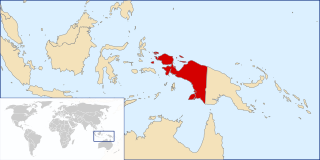
Papua New Guinea, officially the Independent State of Papua New Guinea, is a country in Oceania that comprises the eastern half of the island of New Guinea and its offshore islands in Melanesia. It shares its only land border with Indonesia to the west and its other close neighbours are Australia to the south and the Solomon Islands to the east. Its capital, located on its southern coast, is Port Moresby. The country is the world's third largest island country, with an area of 462,840 km2 (178,700 sq mi).

The Australasian wrens are a family, Maluridae, of small, insectivorous passerine birds endemic to Australia and New Guinea. While commonly known as wrens, they are unrelated to the true wrens. The family comprises 32 species in six genera.

The Pomatostomidae are small to medium-sized birds endemic to Australia-New Guinea. For many years, the Australo-Papuan babblers were classified, rather uncertainly, with the Old World babblers (Timaliidae), on the grounds of similar appearance and habits. More recent research, however, indicates that they are too basal to belong the Passerida – let alone the Sylvioidea where the Old World babblers are placed – and they are now classed as a separate family close to the Orthonychidae (logrunners). Five species in two genus are currently recognised, although the red-breasted subspecies rubeculus of the grey-crowned babbler may prove to be a separate species.

Psophodidae is a family of passerine birds native to Australia and nearby areas. It has a complicated taxonomic history and different authors vary in which birds they include in the family. In the strictest sense, it includes only the five or six species of whipbirds and wedgebills, but some authors also include the quail-thrushes (Cinclosoma), eight species of ground-dwelling birds found in Australia and New Guinea, and the jewel-babblers (Ptilorrhoa), three or four species found in rainforest in New Guinea. Others place them in their own family, the Cinclosomatidae. The Malaysian rail-babbler was formerly sometimes placed in this family, which would then be called Eupetidae.

The flag of Papua New Guinea was adopted on 1 July 1971. In the hoist, it depicts the Southern Cross; in the fly, a Raggiana bird-of-paradise is silhouetted. The design was chosen through a nationwide design competition in early 1971. The winning designer was Susan Karike, who was 15 at the time.

The Bismarck Sea lies in the south-western Pacific Ocean within the Papua New Guinean exclusive economic zone. It is located north-east of the island of New Guinea and south of the Bismarck Archipelago. It has coastlines in districts of the Islands Region, Momase Region, and Papua Region.

Western New Guinea, also known as Papua, Indonesian New Guinea, and Indonesian Papua, is the western half of the island of New Guinea, formerly Dutch and granted to Indonesia in 1962. Given the island is alternatively named Papua, the region is also called West Papua.

Pomatostomus is a genus of small to medium-sized birds endemic to Australia-New Guinea. All four species are distributed in Australia, and only the grey-crowned babbler could also be found in south New Guinea.

Papua New Guinean art refers to visual art created in Papua New Guinea or by Papua New Guinean artists. Papua New Guinea has been inhabited by humans for roughly 50,000 years; throughout that period, the hundreds of distinct ethnic groups of the island developed unique artistics traditions and styles. Statues and figurines, ritual masks, carvings, and weavings, all generally with spiritual and religious significance, comprise a majority of the art created historically in Papua New Guinea. In the late 20th century, a contemporary art movement emerged roughly the same time as the country gained its independence in the 1970s. This movement reflected both the nation's tribal traditions and customs as well as its progression towards modernization.

The mangrove robin is a passerine bird in the family Petroicidae. It is found in the Aru Islands, New Guinea, and northern Australia. The bird's common name refers to its natural habitat. They live in mangrove forests and seldom fly outside these biomes.

The canary flyrobin, also known as the Papuan flycatcher, canary robin, canary flycatcher, or montane flycatcher, is a species of bird in the family Petroicidae. It is found in New Guinea. Its natural habitat is subtropical or tropical moist montane forests with elevations from 1,100–3,500 m (3,609–11,483 ft). Currently, its population is believed to be stable.

The black-throated robin is a species of passerine bird in the Australisian robin family Petroicidae. It is found on the island of New Guinea. Its natural habitat is subtropical or tropical moist montane forests at 1,150–2,750 metres above sea-level.

The black-chinned robin is a species of bird in the Australasian robin family Petroicidae. It is the only species placed in the genus Leucophantes. It is found in northern New Guinea where its natural habitat is subtropical or tropical moist lowland forests.

The grey-crowned babbler is a species of bird in the family Pomatostomidae. They are found in Australia and New Guinea . Its habitats include tropical and subtropical dry broadlife forests, tropical moist lowland forests, shrublands, and savannas.

The Louisiade white-eye or islet white-eye is a species of bird in the family Zosteropidae. It is endemic to Papua New Guinea, where it is found on widely disjunct islets on both the Bismarck and Louisiade archipelagos.

The Engan languages, or more precisely Enga–Kewa–Huli or Enga – Southern Highland, are a small family of Papuan languages of the highlands of Papua New Guinea. The two branches of the family are rather distantly related, but were connected by Franklin and Voorhoeve (1973).

Cinclosomatidae is a family of passerine birds native to Australia and New Guinea. It has a complicated taxonomic history and different authors vary in which birds they include in the family. It includes the quail-thrushes and jewel-babblers.


















